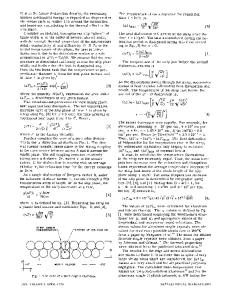The effect of plastic deformation on the martensite-to-austenite transition in an iron-nickel alloy
- PDF / 896,215 Bytes
- 6 Pages / 612 x 792 pts (letter) Page_size
- 105 Downloads / 369 Views
the m a r t e n s i t e - a u s t e n i t e i n t e r f a c e . I n c r e a s i n g the y i e l d s t r e n g t h by alloying d e c r e a s e d Ms in the s a m e m a n n e r . In a s i m i l a r study, A n k a r a 1~ used t r a n s f o r m a t i o n cycling of an F e - 3 0 pct Ni alloy to i n c r e a s e the a u s t e n i t e y i e l d s t r e n g t h and also found a d e c r e a s e in Ms with i n c r e a s i n g yield s t r e n g t h , which he a t t r i buted to a change in d i s l o c a t i o n d e n s i t y . The p u r p o s e of the p r e s e n t study i s to i n v e s t i g a t e the effect of d e f o r m a t i o n applied below Ad on the m a r t e n s i t e - t o - a u s t e n i t e (i.e., the r e v e r s e ) t r a n s f o r m a t i o n in an F e - 3 0 . 3 wt pct Ni--0.005 wt pct C alloy, and to t h e r e b y i n f e r the m e c h a n i s m s r e s p o n s i b l e for the effect of the p r i o r d e f o r m a t i o n . T h i s i s a c c o m p l i s h e d by d e t e r m i n i n g As for s a m p l e s containing various martensite percentages subjected to c o n t r o l l e d d e f o r m a t i o n . The change in yield s t r e n g t h a c c o m p a n y i n g the d e f o r m a t i o n is i n f e r r e d f r o m m i c r o h a r d n e s s m e a s u r e m e n t s on both the a u s tenite and m a r t e n s i t e . A l t e r n a t e m o d e l s for the i n i tiation of the new a u s t e n i t e phase are d i s c u s s e d . 1) EXPERIMENTAL Specimens were fabricated from a blend of high purity iron and nickel powders which were pressed and sintered and then rolled with intermittent annealings to a final thickness of 0.004 in. (4 mils). The chemical composition is shown in Table I. After final reduction to 4 mils the sheet material was annealed 4 h at 1000~ in a hydrogen atmosphere, cooled at 200~ per hour to 200~ and air cooled to room temperature. Samples containing 33, 50, 67, and 95 pct martensite were prepared by controlling both the quench temperature and the time at the quench temperature. The maximum martensite percentage, 95 pct, was obtained by quenchingin liquid nitrogen for 72 h as compared to 33 pct martensite being formed by quenching at -24~ for 7 rain. Specific values for the martensite content in each sample were determined by standard surface metallography. X-ray scans showed considerable preferred orientation, hence no useful information on phase compositions was obtained through X-ray measurements. The martensitic microstructure for the 95 pct martensite sample is shown in Fig. 1. It is observed that some relatively long ~'bands" of martensite exist with a more random fine martensite structure beVOLUME 3, AUGUST 1972-2151
Table I. Material Chemical Composition
Element
Fe
Ni
Weight Percent
Balance
30.3
C
Data Loading...











